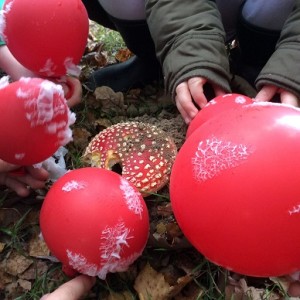
Mushrooms and toadstools are fascinating. Neither plant nor animal, they belong in their own kingdom, the ‘Kingdom of Fungi’ and form a largely invisible world hidden under your feet. It’s the strange fruiting bodies of the fungi that you notice, especially during the wet and mild autumn months, appearing in a wonderful range of colours, shapes and textures. Become a fungus detective and discover the incredibly important but secretive world of fungi through these fun activity ideas.
Suggested activities:
Fungi ‘True or False’ name game: A fun introduction to the weird but wonderfully descriptive world of fungi names, such as redleg jellybaby and dingy twiglet. In groups of 8-10, have enough real and made up fungi names for everyone to try and guess if theirs is ‘true or false’. There’s always lots of laughter when the answers are shared with the groups. The list of recommended English names for UK fungi can be found at: http://www.britmycolsoc.org.uk/library/english-names/
The good, the bad and the ugly: The main body of a fungus is hidden from view as thin threads of hyphae which branch out to from a mass of threads called mycelium – the fungus body. Many are saprotrophs, helping to break down decaying wood and leaf litter, or form symbiotic partnerships with trees to help them grow – the good fungi. Some are parasites and feed off living plants and trees, sometimes killing them – the bad fungi. Whilst some are just ugly looking, such as the ugly milk cap. Challenge the group to find these different types of fungi on a foray.
Fungi foray tips: Plan a short foray to look for fungi in your local play space or woodland. You can find species everywhere, even between cracks in pavements or on animal dung. Tips: Be safe – check the site first and do not collect any fungi to eat. Look but don’t touch, as there are some poisonous species that shouldn’t be handled. A small hand mirror is perfect for looking under caps without picking. Always refer to a good identification book for guidance such as ‘Mushroom Hunting – how to safely identify edible wild mushrooms’ by HarperCollins.
How a mushroom got its spots: The classic fairy tale image of a mushroom, with its red cap and white spots – the fly agaric – makes a fun activity to see how a fruiting body grows. The spots are the remnants of the universal veil, a protective structure that splits, leaving spots on the cap as the fungus grows out of the ground.
You need a red balloon, which represents the fruit body. The universal veil is tissue wrapped around the balloon. The tissue is then sprayed with water, as fungi need water to grow, and the balloon is then inflated. As the balloon expands (the growing mushroom) the tissue splits to leave the distinctive white spots on the cap. Simple and works brilliantly!
Spore prints: A mushroom produces millions of spores, like tiny plant seeds, which most species produced under the cap. The spore colour is an important identification feature. To make a ‘spore print’ of the mushroom, remove the stem and place the cap, with gills or pores, face down onto a sheet of black or white paper depending on the spore colour. Cover with a small bowl to stop it drying out and leave for 3-4 hours, before revealing its beautiful spore pattern.
Design a fantastical fungi: To extending learning from the ‘true or false’ name game and after a fungi foray, challenge groups or individuals to design their own fungi. Is it a helpful recycler or a parasitic fungus, where does it live (its habitat), does it have gills, pores or spines, what size / colour? Use mushroom field guides for ideas and descriptions, and most importantly name this new species.
